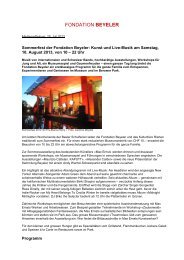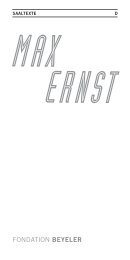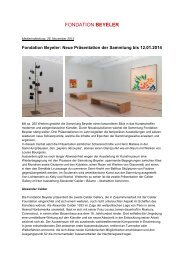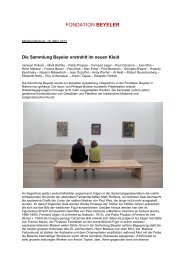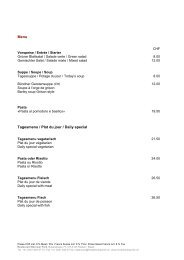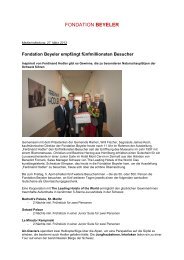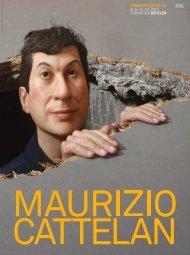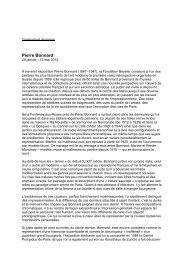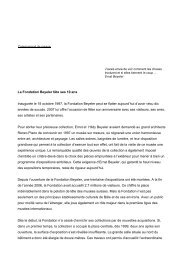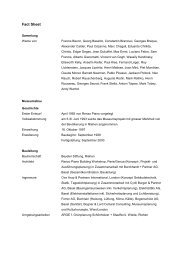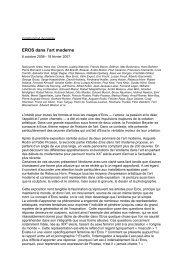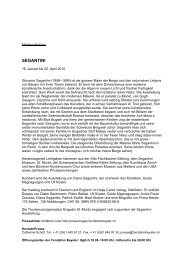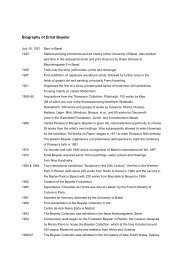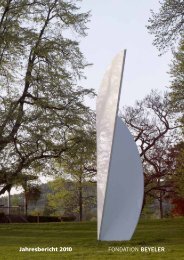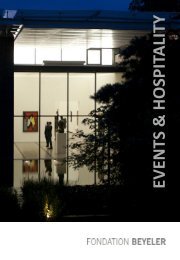Surrealism in Paris - Fondation Beyeler
Surrealism in Paris - Fondation Beyeler
Surrealism in Paris - Fondation Beyeler
Create successful ePaper yourself
Turn your PDF publications into a flip-book with our unique Google optimized e-Paper software.
Press Release<br />
<strong>Surrealism</strong> <strong>in</strong> <strong>Paris</strong><br />
October 2, 2011 – January 29, 2012<br />
The <strong>Fondation</strong> <strong>Beyeler</strong> is devot<strong>in</strong>g the first-ever comprehensive exhibition <strong>in</strong> Switzerland to<br />
<strong>Surrealism</strong> <strong>in</strong> <strong>Paris</strong>. On view will be major works by artists such as Salvador Dalí, René<br />
Magritte, Joan Miró, and many more who either belonged to the movement or were<br />
associated with it. <strong>Surrealism</strong> was one of the most crucial artistic and literary movements of<br />
the twentieth century and had a last<strong>in</strong>g <strong>in</strong>fluence on it. After emerg<strong>in</strong>g <strong>in</strong> <strong>Paris</strong> <strong>in</strong> 1924, the<br />
movement unfolded a worldwide impact. Influenced by the writ<strong>in</strong>gs of Sigmund Freud and<br />
under the leadership of its chief theoretician, André Breton, the Surrealists set out to change<br />
life and society by means of a new brand of art and poetry. Tapp<strong>in</strong>g the unconscious m<strong>in</strong>d<br />
and world of dreams was to trigger an entirely unprecedented k<strong>in</strong>d of creativity. "Dalí,<br />
Magritte, Miró – <strong>Surrealism</strong> <strong>in</strong> <strong>Paris</strong>" comprises about 290 masterworks and manuscripts by<br />
about 40 artists and authors.<br />
The highlights will <strong>in</strong>clude a presentation of the legendary Surrealist private collections<br />
amassed by Peggy Guggenheim and by Breton’s first wife Simone Coll<strong>in</strong>et. In addition to<br />
famous pa<strong>in</strong>t<strong>in</strong>gs and sculptures, objects, photographs, draw<strong>in</strong>gs, manuscripts, jewelry and<br />
films await discovery.<br />
The loans to the exhibition stem from renowned private collections and public museums, <strong>in</strong><br />
Europe and the United States.<br />
The exhibition is curated by Philippe Büttner, <strong>Fondation</strong> <strong>Beyeler</strong> curator.<br />
The exhibition is accompanied by an abundantly illustrated scholarly catalogue, published <strong>in</strong><br />
a German and English edition by Hatje Cantz Verlag, Ostfildern. It conta<strong>in</strong>s essays by<br />
Quent<strong>in</strong> Bajac, Philippe Büttner, Julia Drost, Annabelle Görgen, Ioana Jimborean, Robert<br />
Kopp, Ulf Küster, Guido Magnaguagno, Philip Rylands, Marlen Schneider, Jonas Storsve<br />
und Oliver Wick, and a chronology of <strong>Surrealism</strong> by Valent<strong>in</strong>a Locatelli; 289 pages and 304<br />
full-color illustrations.<br />
ISBN: 978-3-7757-3161-4, CHF 68.00.<br />
A second exhibition venue is planned, at the Musées royaux des Beaux-Arts de Belgique <strong>in</strong><br />
Brussels (March to July 2012).<br />
Press images available at: http://pressimages.fondationbeyeler.ch<br />
Further <strong>in</strong>formation:<br />
Cather<strong>in</strong>e Schott, Head of Public Relations<br />
Tel. + 41 (0)61 645 97 21, presse@fondationbeyeler.ch, www.fondationbeyeler.ch<br />
<strong>Fondation</strong> <strong>Beyeler</strong>, <strong>Beyeler</strong> Museum AG, Baselstrasse 77, CH-4125 Riehen<br />
<strong>Fondation</strong> <strong>Beyeler</strong> open<strong>in</strong>g hours: 10.00 am to 6.00 pm, Wednesdays to 8.00 pm
Press Release<br />
<strong>Surrealism</strong> <strong>in</strong> <strong>Paris</strong><br />
October 2, 2011 – January 29, 2012<br />
The <strong>Fondation</strong> <strong>Beyeler</strong> is devot<strong>in</strong>g the first-ever comprehensive exhibition <strong>in</strong> Switzerland to<br />
<strong>Surrealism</strong> <strong>in</strong> <strong>Paris</strong>. On view will be major works by artists such as Salvador Dalí, Joan Miró,<br />
Max Ernst, and many more who either belonged to the movement or were associated with it.<br />
The show will focus on the <strong>in</strong>novative forms of expression developed and employed by the<br />
Surrealists – especially object art, collage, photography and film.<br />
<strong>Surrealism</strong> was one of the most crucial artistic and literary movements of the twentieth<br />
century. After emerg<strong>in</strong>g <strong>in</strong> <strong>Paris</strong> <strong>in</strong> 1924, it unfolded a worldwide effect that cont<strong>in</strong>ues to this<br />
day. Major modern artists belonged to the movement, were associated with it, or <strong>in</strong>spired by<br />
it. Its aim was radical change and expansion of the expressive means of art and poetry and<br />
their impact on society. Aspects of the psyche and creativity that had previously lay fallow<br />
were to be made fertile for artistic activity and human life as a whole.<br />
Profoundly shaken by the experience of the First World War and under the leadership of its<br />
chief theoretician, André Breton, the Surrealists developed <strong>in</strong>novative approaches and lent<br />
form to an art that tapped poetic imag<strong>in</strong>ation, the world of dreams, and the unconscious<br />
m<strong>in</strong>d. Their idols <strong>in</strong>cluded Sigmund Freud and many writers, such as the scandalous Marquis<br />
de Sade, the poets Charles Baudelaire, Comte de Lautréamont, and Arthur Rimbaud, Edgar<br />
Allan Poe, and the German Romantics.<br />
"Dalí, Magritte, Miró – <strong>Surrealism</strong> <strong>in</strong> <strong>Paris</strong>" comprises about 290 masterworks and manuscripts<br />
by about 40 artists and authors. These <strong>in</strong>clude approximately 110 pa<strong>in</strong>t<strong>in</strong>gs, 30<br />
objects and sculptures, 50 works on paper, 50 photographs, 30 manuscripts and orig<strong>in</strong>al<br />
editions, 15 pieces of jewelry and four films. The exhibits are arranged <strong>in</strong> the exhibition<br />
spaces partly by artist, partly by theme. The <strong>in</strong>troduction is provided by Giorgio de Chirico, a<br />
pioneer<strong>in</strong>g predecessor of <strong>Surrealism</strong> whose cityscapes and <strong>in</strong>teriors of the 1910s can be<br />
considered decisive forerunners of the movement. On view as well are valuable manuscripts<br />
and editions of Surrealist texts, <strong>in</strong>clud<strong>in</strong>g manuscript versions of Breton's manifestos.<br />
A further emphasis is placed on two major artists of the movement, Joan Miró and Max Ernst.<br />
Miró, who opened out entirely new spaces for modern art with his hover<strong>in</strong>g dreamlike colored<br />
configurations, is represented by works such as Pa<strong>in</strong>t<strong>in</strong>g (The Circus Horse), 1927, from the<br />
Metropolitan Museum of Art, New York, and Ernst by superb works such as the renowned<br />
Waver<strong>in</strong>g Woman (The Slant<strong>in</strong>g Woman), 1923, from the Kunstsammlung Nordrhe<strong>in</strong>-<br />
Westfalen, Düsseldorf. Then follows a room devoted to Yves Tanguy, whose imag<strong>in</strong>ary<br />
spaces populated by mysterious objects – as <strong>in</strong> the monumental The Last Days, 1944, from<br />
a private collection – represent one of the most poetic evocations <strong>in</strong> all <strong>Surrealism</strong>. The next<br />
space is devoted to a key Surrealist medium – the object. The works on view <strong>in</strong>clude Meret<br />
Oppenheim's famous Ma gouvernante - My Nurse - Me<strong>in</strong> K<strong>in</strong>dermädchen, 1936/1967, from<br />
the Moderna Museet Stockholm, and Hans Bellmer's major object The Doll, 1935-36, from<br />
the Centre Georges Pompidou, <strong>Paris</strong>. Also brought together here are major draw<strong>in</strong>gs and<br />
pa<strong>in</strong>t<strong>in</strong>gs by Victor Brauner.
A special feature of the exhibition is the <strong>in</strong>clusion of two superb private collections of<br />
<strong>Surrealism</strong>. The presentation of that of André Breton and his first wife, Simone Coll<strong>in</strong>et,<br />
represents a premiere. The couple amassed the collection <strong>in</strong> the 1920s, and after they<br />
separated Coll<strong>in</strong>et expanded her share. Among the works <strong>in</strong> the collection are Francis<br />
Picabia's large-scale pa<strong>in</strong>t<strong>in</strong>g Judith, 1929, and de Chirico's The Evil Genius of a K<strong>in</strong>g, 1914-<br />
15, now <strong>in</strong> the Museum of Modern Art, New York. On view <strong>in</strong> a second room are outstand<strong>in</strong>g<br />
works from the Peggy Guggenheim Collection, <strong>in</strong>clud<strong>in</strong>g Max Ernst's The Antipope, 1941-42,<br />
which the Peggy Guggenheim Collection <strong>in</strong> Venice seldom permits to travel. These works<br />
constitute an ensemble with<strong>in</strong> the exhibition <strong>in</strong> which the period of the Surrealists' New York<br />
exile dur<strong>in</strong>g World War II is virtually distilled. In addition, the presentation of the two collections<br />
permits us to highlight key aspects of private stag<strong>in</strong>gs of Surrealist art.<br />
The artists prom<strong>in</strong>ently represented <strong>in</strong> further rooms <strong>in</strong>clude Hans Arp, and not least Pablo<br />
Picasso, who for a time was closely associated with <strong>Surrealism</strong>. On view is his highly<br />
Surrealist pa<strong>in</strong>t<strong>in</strong>g The Artist's Studio (The Open W<strong>in</strong>dow), 1929. This is followed by an<br />
outstand<strong>in</strong>g group of works by the visual magician René Magritte. In an <strong>in</strong>imitable way,<br />
Magritte's art captures visual reality only to subvert it aga<strong>in</strong>. F<strong>in</strong>e examples are the early The<br />
Interpretation of Dreams, 1930, and later major works such as The Dom<strong>in</strong>ion of Light, 1962,<br />
both from private collections.<br />
A concise selection of outstand<strong>in</strong>g Surrealist photographs, <strong>in</strong>clud<strong>in</strong>g works by Man Ray,<br />
Raoul Ubac, Dora Maar, and Eli Lotar rounds off the picture. A screen<strong>in</strong>g room presents key<br />
works of Surrealist c<strong>in</strong>ematic art, <strong>in</strong>clud<strong>in</strong>g ones by Luis Buñuel and Man Ray.<br />
The exhibition concludes with the artist who is likely the most famous Surrealist of all,<br />
Salvador Dalí. A spectacular group of his masterpieces on view here <strong>in</strong>cludes The Enigma of<br />
Desire, 1929, from the P<strong>in</strong>akothek der Moderne, Munich, the outstand<strong>in</strong>g Metamorphosis of<br />
Narcissus, 1937, from the Tate London, and Dream Caused by the Flight of a Bee around a<br />
Pomegranate, one Second before Awaken<strong>in</strong>g, 1944, from the Museo Thyssen Bornemisza <strong>in</strong><br />
Madrid.<br />
The exhibition l<strong>in</strong>ks up with previous Galerie <strong>Beyeler</strong> and <strong>Fondation</strong> <strong>Beyeler</strong> projects. Ernst<br />
<strong>Beyeler</strong> early on devoted various exhibitions to <strong>Surrealism</strong> <strong>in</strong> his Basel gallery, <strong>in</strong>clud<strong>in</strong>g the<br />
1947 "Surréalisme et pe<strong>in</strong>ture" and the 1995-96 "<strong>Surrealism</strong>us: Traum des Jahrhunderts," as<br />
well as to <strong>in</strong>dividual representatives of the movement, br<strong>in</strong>g<strong>in</strong>g his unique eye for this art <strong>in</strong>to<br />
play. Accord<strong>in</strong>gly, the <strong>Beyeler</strong> Collection now boasts key works by such artists as Arp, Ernst,<br />
Miró and Picasso. The <strong>Fondation</strong> <strong>Beyeler</strong> can likewise look back on shows of Surrealist art,<br />
<strong>in</strong>clud<strong>in</strong>g "Calder, Miró", 2004, "Picasso surreal," 2005, "René Magritte: The Key to Dreams",<br />
2005, and, with some Surrealist works, "Giacometti", 2009. These were supplemented by<br />
thematic exhibitions <strong>in</strong> which Surrealist art prom<strong>in</strong>ently figured. The current extensive <strong>Surrealism</strong><br />
exhibition provides a panoramic view of the movement as a whole.<br />
The exhibition is curated by Philippe Büttner, <strong>Fondation</strong> <strong>Beyeler</strong> Curator.<br />
In addition to private lenders, the most important <strong>in</strong>stitutional lenders are: The Peggy<br />
Guggenheim Collection, Venice (The Solomon R. Guggenheim <strong>Fondation</strong>, New York); the<br />
Centre Georges Pompidou; Musée national d’art moderne, <strong>Paris</strong>; das Musée d’Art moderne<br />
de la Ville de <strong>Paris</strong>; Tate, London; Bayerische Staatsgemäldesammlungen, Munich –<br />
P<strong>in</strong>akothek der Moderne; Kunstsammlung Nordrhe<strong>in</strong>-Westfalen, Düsseldorf; Museum<br />
Ludwig, Cologne; Staatliche Museen zu Berl<strong>in</strong>, Nationalgalerie; Museo Nacional Centro de<br />
Arte Re<strong>in</strong>a Sofia, Madrid; Museo Thyssen-Bornemisza, Madrid; das Museu Coleccao<br />
Berardo, Lisbon; The Metropolitan Museum of Art, New York; The Menil Collection, Houston;<br />
The Museum of Modern Art, New York; the National Gallery of Art, Wash<strong>in</strong>gton; the<br />
Philadelphia Museum of Art and the Kunstmuseum Basel and Kupferstichkab<strong>in</strong>ett and the<br />
Kunsthaus Zürich and Alberto Giacometti-Stiftung.
The catalogue, published by <strong>Beyeler</strong> Museum AG and edited by Philippe Büttner, provides<br />
an <strong>in</strong>troduction to the movement, presents the works on exhibit, and gives special attention<br />
to the question of the presentation of Surrealist art – both by the Surrealists themselves and<br />
<strong>in</strong> private collections. It conta<strong>in</strong>s essays by Quent<strong>in</strong> Bajac, Philippe Büttner, Julia Drost,<br />
Annabelle Görgen, Ioana Jimborean, Robert Kopp, Ulf Küster, Guido Magnaguagno, Philip<br />
Rylands, Marlen Schneider, Jonas Storsve und Oliver Wick, and a chronology of <strong>Surrealism</strong><br />
by Valent<strong>in</strong>a Locatelli. The lavishly illustrated exhibition catalogue is published <strong>in</strong> a German<br />
and English edition by Hatje Cantz Verlag, Ostfildern, 289 pages and 304 full-color<br />
illustrations. ISBN: 978-3-7757-3161-4, CHF 68.00.<br />
A second exhibition venue is planned, at the Musées royaux des Beaux-Arts de Belgique <strong>in</strong><br />
Brussels (March to July 2012).<br />
The exhibition has been generous supported from kulturelles.bl.<br />
Press images available at: http://pressimages.fondationbeyeler.ch<br />
Further <strong>in</strong>formation:<br />
Cather<strong>in</strong>e Schott, Head of Public Relations<br />
Tel. + 41 (0)61 645 97 21, presse@fondationbeyeler.ch, www.fondationbeyeler.ch<br />
<strong>Fondation</strong> <strong>Beyeler</strong>, <strong>Beyeler</strong> Museum AG, Baselstrasse 77, CH-4125 Riehen, Switzerland<br />
<strong>Fondation</strong> <strong>Beyeler</strong> open<strong>in</strong>g hours: 10.00 am to 6.00 pm, Wednesdays to 8.00 pm
01 Hans Bellmer<br />
La poupée, 1935 / 36<br />
The Doll<br />
Pa<strong>in</strong>ted wood, papier mâché,<br />
and mixed media, 61 × 170 × 51 cm<br />
Centre Georges Pompidou, Musée<br />
national d’art moderne, <strong>Paris</strong><br />
Photo: © Collection Centre Pompidou,<br />
dist. by RMn, <strong>Paris</strong> / Georges<br />
Meguerditchian<br />
© 2011, ProLittteris, Zurich<br />
06 Salvador Dalí<br />
Cygnes réfléchis en éléphants, 1937<br />
Swans Reflect<strong>in</strong>g Elephants<br />
oil on canvas, 51 × 77 cm<br />
Private collection, Switzerland<br />
© 2011, Fundació Gala-Salvador dalí /<br />
ProLitteris, Zurich<br />
11 Alberto Giacometti<br />
Femme égorgée, 1932 / 1940<br />
Woman with Her Throat Cut<br />
Bronze, 23.2 × 89 cm<br />
Peggy Guggenheim Collection, Venice<br />
(Solomon R. Guggenheim Foundation,<br />
new York)<br />
Photo: david Heald © the Solomon<br />
R. Guggenheim Foundation<br />
© 2011, <strong>Fondation</strong> Giacometti /<br />
ProLitteris, Zurich<br />
02 Alexander Calder<br />
Dancers and Sphere, 1936<br />
Pa<strong>in</strong>ted wood, sheet metal, wire, and<br />
110 volt motor, 10 × 64.5 × 29 cm<br />
Courtesy Galerie natalie Seroussi, <strong>Paris</strong><br />
© 2011, Calder Foundation, new York /<br />
ProLitteris, Zurich<br />
07 Salvador Dalí<br />
Rêve causé par le vol d‘une abeille<br />
autour d‘une pomme-grenade,<br />
une seconde avant l‘éveil, 1944<br />
Dream Caused by the Flight of a Bee<br />
around a Pomegranate, one Second<br />
before Awaken<strong>in</strong>g<br />
oil on wood, 51 × 41 cm<br />
Museo thyssen-Bornemisza, Madrid<br />
Photo: © Museo thyssen-Bornemisza,<br />
Madrid<br />
© 2011, Fundació Gala-Salvador dalí /<br />
ProLitteris, Zurich<br />
12 rené Magritte<br />
L’esprit comique, 1928<br />
The Spirit of Comedy<br />
oil on canvas, 75 × 60 cm<br />
Ulla and He<strong>in</strong>er Pietzsch Collection, Berl<strong>in</strong><br />
Photo: Jochen Littkemann, Berl<strong>in</strong><br />
© 2011, ProLitteris, Zurich<br />
<strong>Fondation</strong> <strong>Beyeler</strong><br />
03 Giorgio de Chirico<br />
Le mauvais génie d’un roi, 1914 –15<br />
The Evil Genius of a K<strong>in</strong>g<br />
oil on canvas, 61 × 50.2 cm<br />
the Museum of Modern art, new York<br />
Photo: © 2011, the Museum of Modern<br />
art, new York / dist. by Scala, Florence<br />
© 2011, ProLitteris, Zurich<br />
08 Paul Delvaux<br />
Pygmalion, 1939<br />
oil on wood, 117 × 148 cm<br />
Royal Museums of F<strong>in</strong>e arts of Belgium,<br />
Brussels<br />
Photo: © Royal Museums of F<strong>in</strong>e arts<br />
of Belgium, Brussels / J. Geleyns<br />
© 2011, Fond. P. delvaux S. idesbald,<br />
Belgien / ProLitteris, Zurich<br />
13 rené Magritte<br />
La clef des songes, 1930<br />
The Interpretation of Dreams<br />
oil on canvas, 81 × 60 cm<br />
Private collection<br />
© 2011, ProLitteris, Zurich<br />
04 Salvador Dalí<br />
L’énigme du désir, 1929<br />
The Enigma of Desire<br />
oil on canvas, 110.5 × 150.5 cm<br />
Bayerische Staatsgemäldesammlungen,<br />
Munich – P<strong>in</strong>akothek der Moderne<br />
Photo: © Blauel / Gnamm – aRtotHEK<br />
© 2011, Fundació Gala-Salvador dalí /<br />
ProLitteris, Zurich<br />
09 Max ernst<br />
La ville entière, 1935 – 36<br />
The Entire City<br />
oil on canvas, 60 × 81 cm<br />
Kunsthaus Zürich<br />
Photo: Kunsthaus Zürich<br />
© 2011, ProLitteris, Zurich<br />
14 rené Magritte<br />
La voix des airs, 1931<br />
Voice of Space<br />
oil on canvas, 72.7 × 54.2 cm<br />
Peggy Guggenheim Collection, Venice<br />
(Solomon R. Guggenheim Foundation,<br />
new York)<br />
Photo: david Heald © the Solomon<br />
R. Guggenheim Foundation<br />
© 2011, ProLitteris, Zurich<br />
October 2, 2011 to January 29, 2012<br />
05 Salvador Dalí<br />
Construction molle avec haricots bouillis –<br />
Prémonition de la guerre civile, 1936<br />
Soft Construction with Boiled Beans –<br />
Premonition of Civil War<br />
oil on canvas, 100 × 100 cm<br />
Philadelphia Museum of art, the Louise<br />
and Walter arensberg Collection, 1950<br />
Photo: Philadelphia Museum of art<br />
© 2011, Fundació Gala-Salvador dalí /<br />
ProLitteris, Zurich<br />
10 Max ernst<br />
L’antipape, 1941– 42<br />
The Antipope<br />
oil on canvas, 160.8 × 127.1 cm<br />
Peggy Guggenheim Collection, Venice<br />
(Solomon R. Guggenheim Foundation,<br />
new York)<br />
Photo: david Heald © the Solomon<br />
R. Guggenheim Foundation<br />
© 2011, ProLitteris, Zurich<br />
15 rené Magritte<br />
La grande guerre, 1964<br />
The Great War<br />
oil on canvas, 65 × 54 cm<br />
Private collection, Switzerland<br />
Photo: Robert Bayer, Basel<br />
© 2011, ProLitteris, Zurich<br />
Press images http://pressimages.fondationbeyeler.ch<br />
this visual material may be used for press purposes only. Reproduction is permitted for the duration of the exhibition only.<br />
Please employ the captions as given and the relevant copyrights. We k<strong>in</strong>dly request you to forward us a voucher copy.
16 Joan Miró<br />
Pe<strong>in</strong>ture (Le cheval de cirque), 1927<br />
Pa<strong>in</strong>t<strong>in</strong>g (The Circus Horse)<br />
tempera on canvas, 130.5 × 97.2 cm<br />
the Metropolitan Museum of art,<br />
new York, the Muriel Kallis Ste<strong>in</strong>berg<br />
newman Collection<br />
Photo: bpk, Berl<strong>in</strong> / the Metropolitan<br />
Museum of art, new York<br />
© 2011, Successió Miró /<br />
ProLitteris, Zurich<br />
21 Man ray<br />
Indestructible Object, 1923 / 1933 / 1965<br />
Metronome and photograph,<br />
22.5 × 11 × 11.5 cm<br />
Gallery Marion Meyer contempora<strong>in</strong>, <strong>Paris</strong><br />
Photo: Marc domage<br />
© 2011, Man Ray trust, <strong>Paris</strong> /<br />
ProLitteris, Zurich<br />
25 yves Tanguy<br />
Earr<strong>in</strong>gs, c. 1938<br />
Silver, gold, pearls, and oil on shell<br />
Blue-green earr<strong>in</strong>g: 7 × 3.7 × 1.6 cm<br />
P<strong>in</strong>k earr<strong>in</strong>g: 7.1 × 3.7 × 1.6 cm<br />
Solomon R. Guggenheim Foundation,<br />
Venice<br />
Photo: Sergio Martucci<br />
© 2011, ProLitteris, Zurich<br />
17 Joan Miró<br />
Pe<strong>in</strong>ture (« escargot, femme, fleur,<br />
étoile »), 1934<br />
Pa<strong>in</strong>t<strong>in</strong>g (“Snail, Woman, Flower Star”)<br />
oil on canvas, 195 × 172 cm<br />
Museo nacional Centro de arte Re<strong>in</strong>a<br />
Sofía, Madrid<br />
Photo: archivo fotográfico Museo<br />
nacional Centro de arte Re<strong>in</strong>a Sofía,<br />
Madrid<br />
© 2011, Successió Miró /<br />
ProLitteris, Zurich<br />
22 Man ray<br />
Members <strong>in</strong> the Bureau central de<br />
recherches surréalistes, 1924<br />
Gelat<strong>in</strong> silver pr<strong>in</strong>t, 8.2 × 11.2 cm<br />
(From left to right, stand<strong>in</strong>g:<br />
Jacques Baron, Raymond Queneau,<br />
Pierre naville, andré Breton, Jacquesandré<br />
Boiffard, Giorgio de Chirico,<br />
Roger Vitrac, Paul Eluard, Philippe<br />
Soupault, Robert desnos, and Louis<br />
aragon; seated: Simone Breton,<br />
Max Morise, Marie-Louise Soupault)<br />
Private collection<br />
Photo: Jean-Louis Losi, <strong>Paris</strong><br />
© 2011, Man Ray trust, <strong>Paris</strong> /<br />
ProLitteris, Zurich<br />
26 yves Tanguy<br />
Les jeux nouveaux, 1940<br />
New Games<br />
oil on canvas, 33 × 40.7 cm<br />
natalie and Léon Seroussi Collection, <strong>Paris</strong><br />
© 2011, ProLitteris, Zurich<br />
<strong>Fondation</strong> <strong>Beyeler</strong><br />
18 Meret Oppenheim<br />
Ma gouvernante – my nurse – me<strong>in</strong><br />
K<strong>in</strong>dermädchen, 1936 / 1967<br />
Shoes, paper, str<strong>in</strong>g, and metal,<br />
14 × 33 × 21 cm<br />
Moderna Museet, Stockholm<br />
Photo: Moderna Museet, Stockholm<br />
© 2011, ProLitteris, Zurich<br />
23 Man ray<br />
Erotique-voilée, 1933 –34<br />
Veiled Eroticism<br />
Gelat<strong>in</strong> silver pr<strong>in</strong>t, 12 × 9 cm<br />
Private collection, courtesy<br />
Galerie 1900–2000, <strong>Paris</strong><br />
© 2011, Man Ray trust, <strong>Paris</strong> /<br />
ProLitteris, Zurich<br />
19 Francis Picabia<br />
Dresseur d’animaux, 1923<br />
The Animal Tamer<br />
Ripol<strong>in</strong> on canvas, 250 × 200 cm<br />
Centre Georges Pompidou, Musée<br />
national d’art moderne, <strong>Paris</strong><br />
Photo: © Collection Centre Pompidou,<br />
dist. by RMn, <strong>Paris</strong> / Georges<br />
Meguerditchian<br />
© 2011, ProLitteris, Zurich<br />
24 Man ray<br />
Les larmes, 1933 / 1959<br />
The Tears<br />
Later pr<strong>in</strong>t, 48 × 58.5 cm<br />
Städtisches Museum abteiberg,<br />
Mönchengladbach<br />
© 2011, Man Ray trust, <strong>Paris</strong> /<br />
ProLitteris, Zurich<br />
October 2, 2011 to January 29, 2012<br />
20 Pablo Picasso<br />
L’atelier du pe<strong>in</strong>tre (La fenêtre<br />
ouverte), 1929<br />
The Artist’s Studio (The Open W<strong>in</strong>dow)<br />
oil on canvas, 130 × 162 cm<br />
Staatsgalerie Stuttgart, Steegmann<br />
Collection<br />
Photo: © Staatsgalerie Stuttgart<br />
© 2011, Succession Picasso /<br />
ProLitteris, Zurich<br />
Press images http://pressimages.fondationbeyeler.ch<br />
this visual material may be used for press purposes only. Reproduction is permitted for the duration of the exhibition only.<br />
Please employ the captions as given and the relevant copyrights. We k<strong>in</strong>dly request you to forward us a voucher copy.
Biographies<br />
HANS BELLMER (Kattowitz, Upper Silesia, now Poland, 1902-1975)<br />
German sculptor, draftsman and photographer<br />
Hans Bellmer's authoritarian, rigorously puritan father forced him to work <strong>in</strong> coal m<strong>in</strong>es and steel<br />
works from an early age. He found succor <strong>in</strong> the world of his mother, the lov<strong>in</strong>g opposite of his<br />
strict father. Already <strong>in</strong> childhood he transformed his toys, and later took draw<strong>in</strong>g courses at Berl<strong>in</strong><br />
Technical College.<br />
In 1932 Bellmer began creat<strong>in</strong>g what he called an "artificial daughter" -- The Doll -- after see<strong>in</strong>g<br />
The Tales of Hoffmann, an opera about the mechanical doll Olympia and the young Nathaniel's<br />
despair<strong>in</strong>g love for her. Several themes <strong>in</strong>trigued Bellmer: the motifs of the doppelgänger,<br />
deception, passion and demise. He photographed The Doll <strong>in</strong> various poses and published a book<br />
of the images that went through several editions.<br />
From May 1935 onwards he participated <strong>in</strong> every Surrealist group exhibition, show<strong>in</strong>g primarily his<br />
photos of The Doll, which triggered horror and delight among the audience. The artist's work<br />
fasc<strong>in</strong>ated the Surrealists, as they viewed the metamorphosis of the human body as a stage <strong>in</strong> the<br />
cycle of life and death.<br />
ANDRÉ BRETON (T<strong>in</strong>chebray, Brittany, 1896 - <strong>Paris</strong>, 1966)<br />
French poet and writer, founder and theoretician of <strong>Surrealism</strong><br />
In 1900, Breton's bourgeois, orig<strong>in</strong>ally Breton family moved to <strong>Paris</strong>. Devot<strong>in</strong>g himself to poetry<br />
from his senior year on, Breton was pr<strong>in</strong>cipally <strong>in</strong>fluenced by Symbolism, which he preferred to<br />
Zola's Naturalism. In 1915 he began to study medic<strong>in</strong>e, someth<strong>in</strong>g he would later term a "pure<br />
alibi."<br />
On the outbreak of war Breton was still apolitical, yet already critical of the militaristic spirit of the<br />
age. As an <strong>in</strong>tern <strong>in</strong> a neuropsychiatric ward at the front he was confronted by the mental suffer<strong>in</strong>gs<br />
of shell-shocked soldiers. He discovered the writ<strong>in</strong>gs of Freud and developed a great <strong>in</strong>terest <strong>in</strong> the<br />
unconscious m<strong>in</strong>d and the threshold between dreams, imag<strong>in</strong>ation and reality.<br />
Back <strong>in</strong> <strong>Paris</strong>, Breton and his poet friends Aragon and Soupault immersed themselves <strong>in</strong> the dark,<br />
phantasmagorical realm of Isidore Ducasse's Chants of Maldoror, 1874. In 1916 he met the poets<br />
Guillaume Apoll<strong>in</strong>aire and Jacques Vaché, whose works enchanted him. After their death, he<br />
became engaged <strong>in</strong> the journal Littérature <strong>in</strong> 1919. Together with Soupault, he developed "écriture<br />
automatique" and participated <strong>in</strong> Dada demonstrations <strong>in</strong> <strong>Paris</strong>. He married Simone Kahn <strong>in</strong> 1921.<br />
The two worked <strong>in</strong> the Office of Surrealist Research and supported themselves, among other<br />
th<strong>in</strong>gs, by deal<strong>in</strong>g <strong>in</strong> art. Breton discovered and furthered artists such as de Chirico, Ernst, Man<br />
Ray, and others.<br />
In 1924 Breton wrote the first Surrealist Manifesto, establish<strong>in</strong>g the premises and orientation of the<br />
movement.<br />
Due to his desire for social and political change, Breton established ties with the French<br />
Communist Party <strong>in</strong> 1927. Yet detest<strong>in</strong>g any k<strong>in</strong>d of dogmatism, he distanced himself from it aga<strong>in</strong><br />
as early as 1935. In a second Surrealist Manifesto, 1930, he def<strong>in</strong>ed the task of <strong>Surrealism</strong> as<br />
revolutioniz<strong>in</strong>g society, from social conditions to aesthetic attitudes. There followed lectures,
exhibitions, and new periodicals (after La révolution surréaliste, 1924, Le surréalisme au service de<br />
la révolution, 1930-33, M<strong>in</strong>otaure, 1933-39).<br />
After the outbreak of World War II, Breton and many other Surrealists fled to the U.S. He returned<br />
to France <strong>in</strong> 1946, cont<strong>in</strong>u<strong>in</strong>g his publish<strong>in</strong>g activities and efforts on behalf of <strong>Surrealism</strong> until his<br />
death <strong>in</strong> 1966.<br />
SALVADOR DALÍ (Figueres, Catalonia, 1904-1989)<br />
Spanish pa<strong>in</strong>ter, sculptor and set designer<br />
Born <strong>in</strong> 1904, Dalí was confronted by life-shap<strong>in</strong>g events <strong>in</strong> early childhood. The death of his<br />
brother and the love lavished on him by his parents led to a precocious <strong>in</strong>volvement with life and<br />
death. A veritably narcissistic concern with his own identity set <strong>in</strong> as well. His attendance from 1921<br />
at the Real Academia de Bellas Artes <strong>in</strong> Madrid was <strong>in</strong>terrupted by Dalí's provocative behavior, and<br />
from then on he cont<strong>in</strong>ued to teach himself art.<br />
His first show, <strong>in</strong> Barcelona, took place <strong>in</strong> 1925. In 1927 he met Picasso <strong>in</strong> <strong>Paris</strong>, and <strong>in</strong> 1929 Miró,<br />
Breton, Éluard, and his muse, Gala Éluard, who would later become his wife. Breton, for his part,<br />
was <strong>in</strong>itially unsure about Dalí, and later <strong>in</strong>dignant at what he considered his fascist tendencies. In<br />
1934 began a series of attempts orchestrated by Breton to throw Dalí out of the group, but this did<br />
not ultimately happen until 1939. Thus Dalí still contributed illustrations to the Surrealist journal<br />
M<strong>in</strong>otaure <strong>in</strong> 1936 and figured prom<strong>in</strong>ently <strong>in</strong> Duchamp's (and Breton's) legendary 1938 exhibition<br />
<strong>in</strong> <strong>Paris</strong>.<br />
Dalí's art revolves around psychic states to which the artist lent form by means of a visionary<br />
approach. His technique was worthy of an Old Master, enabl<strong>in</strong>g him to anchor the states of dream,<br />
ecstasy, despair and agony conv<strong>in</strong>c<strong>in</strong>gly <strong>in</strong> an objective and figurative reality. Basic elements, such<br />
as the human body and landscapes, as well as objects, became the scene of halluc<strong>in</strong>atory<br />
metamorphosis.<br />
GIORGIO DE CHIRICO (Volos, Greece, 1888 - Rome, 1978)<br />
Italian pa<strong>in</strong>ter<br />
The son of an Italian eng<strong>in</strong>eer, Giorgio de Chirico took draw<strong>in</strong>g classes at the Polytechnical<br />
College <strong>in</strong> Athens as a child. In 1906 his family settled <strong>in</strong> Munich, where he discovered the art of<br />
Arnold Böckl<strong>in</strong> at the Academy of Arts. In 1909 Giorgio and his brother Alberto Sav<strong>in</strong>io moved to<br />
Florence and Tur<strong>in</strong>, whose urban architecture shaped the sett<strong>in</strong>gs of his pa<strong>in</strong>t<strong>in</strong>gs.<br />
In 1911 he befriended Apoll<strong>in</strong>aire and Picasso <strong>in</strong> <strong>Paris</strong>. After 1915 he lived aga<strong>in</strong> <strong>in</strong> Italy, but<br />
reta<strong>in</strong>ed contact with Breton and Éluard, who <strong>in</strong> 1924 began regularly publish<strong>in</strong>g his pa<strong>in</strong>t<strong>in</strong>gs <strong>in</strong><br />
the Surrealist journals. De Chirico was a member of the Office of Surrealist Research.<br />
In the modern tradition, de Chirico's urban views comb<strong>in</strong>ed temples, palaces, arcades, towers,<br />
factories, studios <strong>in</strong>to a mysterious and tragic stage for lonely figures. His <strong>in</strong>teriors of 1914-15<br />
likewise posed riddles and suggested a voyage of discovery through unreal spaces, an aspect that<br />
deeply <strong>in</strong>spired the Surrealists. After 1925 a break with <strong>Surrealism</strong> occurred when de Chirico's<br />
style turned to a neoclassical romanticism.<br />
MAX ERNST (Brühl, Germany, 1891 - <strong>Paris</strong>, 1976)<br />
German pa<strong>in</strong>ter, pr<strong>in</strong>tmaker and sculptor<br />
In 1909 Ernst was a student of philology, philosophy and art history <strong>in</strong> Bonn. Dur<strong>in</strong>g this period he<br />
befriended August Macke, Robert Delaunay and Guillaume Apoll<strong>in</strong>aire, and <strong>in</strong> 1914 met Hans Arp
<strong>in</strong> Cologne. Ernst was <strong>in</strong>ducted <strong>in</strong>to the army <strong>in</strong> 1914. For him, the devastat<strong>in</strong>g experience of<br />
World War I represented a "break from life," to which he returned <strong>in</strong> 1918.<br />
Together with Baargeld and Arp, Ernst established the Cologne Dada movement <strong>in</strong> 1918. This<br />
period also saw him develop<strong>in</strong>g his first collages, which over the follow<strong>in</strong>g years and decades he<br />
would ramify and collect <strong>in</strong> extensive volumes. À l'<strong>in</strong>térieur de la vue, 8 poèmes visibles, would be<br />
published <strong>in</strong> 1931.<br />
In 1922 Ernst moved to <strong>Paris</strong> and jo<strong>in</strong>ed the Surrealist group. He participated <strong>in</strong> every important<br />
exhibition they held. Beg<strong>in</strong>n<strong>in</strong>g <strong>in</strong> 1925, based on the technique of "écriture automatique", he<br />
developed a pa<strong>in</strong>terly version, a rubb<strong>in</strong>g method known as frottage, used for the portfolio Histoire<br />
Naturelle of 1926. Further <strong>in</strong>ventive techniques followed, a scrap<strong>in</strong>g method known as grattage (La<br />
grande fôret, 1927) and a transfer method known as decalcomania (Swampangel, 1940). Ernst<br />
adopted historical, sacred and mythological motifs, but always subjected them to a modern<br />
<strong>in</strong>terpretation.<br />
At the outbreak of the Second World War <strong>in</strong> 1939, Ernst was <strong>in</strong>terned <strong>in</strong> France. In 1940, with the<br />
aid of Peggy Guggenheim, whom he would later marry, he fled to the U.S. After separat<strong>in</strong>g from<br />
her, he lived from 1943 onwards with the artist Dorothea Tann<strong>in</strong>g, who became his wife <strong>in</strong> 1946.<br />
The couple moved to the Arizona desert. In 1953 they returned to France.<br />
ALBERTO GIACOMETTI (Borgonovo, Bergell, Switzerland, 1901 - Chur, 1966)<br />
Swiss sculptor, pr<strong>in</strong>tmaker and pa<strong>in</strong>ter<br />
After study<strong>in</strong>g classical sculpture <strong>in</strong> <strong>Paris</strong>, Giacometti <strong>in</strong>creas<strong>in</strong>gly turned to tribal art, which<br />
<strong>in</strong>spired him to reduce his works to fundamental forms. Femme, 1927, is an example of his striv<strong>in</strong>g<br />
to represent his "image of reality."<br />
Around 1929 he approached the Surrealist circle, spark<strong>in</strong>g a dialogue that led to his idea of the<br />
Surrealist object. The result was <strong>in</strong> part mobile yet <strong>in</strong>variably emotionally charged sculptures that<br />
often provoked <strong>in</strong>dignation. Giacometti had his first one-man show at Galerie Pierre Colle <strong>in</strong> 1932<br />
and participated, among other th<strong>in</strong>gs, <strong>in</strong> the groundbreak<strong>in</strong>g "Exposition surréaliste d'objets" <strong>in</strong><br />
1936 at Galerie Charles Ratton.<br />
He addressed themes of importance to <strong>Surrealism</strong> – sexuality, violence, <strong>in</strong>st<strong>in</strong>ctual drives, fetishes<br />
(Objet desagréable à jeter, 1931), representations of actual and dreamlike spaces, and<br />
(dis)equilibrium. Transformations of the body were depicted through associations with everyday<br />
shapes, such as the spoon as a metaphor for the female body with a cello volute as head.<br />
After break<strong>in</strong>g with the Surrealists <strong>in</strong> 1934, Giacometti returned to a figurative style.<br />
RENÉ MAGRITTE (Less<strong>in</strong>es, Belgium, 1898 - Brussels, 1967)<br />
Belgian pa<strong>in</strong>ter<br />
After study<strong>in</strong>g pa<strong>in</strong>t<strong>in</strong>g at the Académie Royale des Beaux-Arts <strong>in</strong> Brussels from 1916-21, Magritte<br />
became <strong>in</strong>volved <strong>in</strong> Dada, de Stijl, and other avant-garde groups. In 1925, <strong>in</strong>fluenced by Ernst and<br />
de Chirico, he executed his first Surrealist pa<strong>in</strong>t<strong>in</strong>gs. Follow<strong>in</strong>g his first one-man show <strong>in</strong> Brussels<br />
<strong>in</strong> 1927, Magritte participated <strong>in</strong> every Surrealist exhibition <strong>in</strong> <strong>Paris</strong>, London and New York from<br />
1930-40. He lived <strong>in</strong> <strong>Paris</strong> from 1927 to 1930.<br />
Back <strong>in</strong> 1926, the Belgian Surrealists Mesens, Nougé, Goemans and others had formed their own<br />
movement. It was not until 1928 that Breton f<strong>in</strong>ally accepted Magritte. There followed, <strong>in</strong> 1929, a<br />
quarrel with Breton on account of his wife, Georgette's, wish to wear a crucifix; Magritte's expulsion<br />
from the group lasted until 1933. In an animated dialogue with Breton concern<strong>in</strong>g the pr<strong>in</strong>ciples of<br />
<strong>Surrealism</strong>, Magritte always sided with his Belgian fellow artists, who were sceptical of psychic and
artistic automatism.<br />
Characteristic of Magritte's art is an oscillation between an image of reality and reality per se. He<br />
himself spoke <strong>in</strong> 1938 of an "existence <strong>in</strong> two different spaces."<br />
ANDRÉ MASSON (Balagny-sur-Théra<strong>in</strong>, Picardy, 1896-1987)<br />
French pa<strong>in</strong>ter and pr<strong>in</strong>tmaker<br />
Born <strong>in</strong>to a farm<strong>in</strong>g family, Masson was awarded the Grand Prize of the Academy at the age of<br />
sixteen, which enabled him to establish his own studio <strong>in</strong> <strong>Paris</strong>. In 1914 he received a travel<br />
stipend for Italy. Back <strong>in</strong> France, he volunteered for war service. By the time he returned he was<br />
seriously wounded and mentally shaken by his experience of war.<br />
Aga<strong>in</strong> <strong>in</strong> <strong>Paris</strong> around 1922, Masson supported himself by accept<strong>in</strong>g various commissions. Around<br />
1923-24 emerged his first "automatic draw<strong>in</strong>gs", a counterpart to Breton's automatic writ<strong>in</strong>g.The<br />
method <strong>in</strong>volved rapid draw<strong>in</strong>g and pa<strong>in</strong>t<strong>in</strong>g, lett<strong>in</strong>g the hand outstrip conscious thought. It stood<br />
opposed to collage, which, as Clébert noted, attempted to capture the permanence of the image.<br />
Masson's draw<strong>in</strong>gs were published <strong>in</strong> La révolution surréaliste, and he became a member of the<br />
journal's staff.<br />
After go<strong>in</strong>g <strong>in</strong>to American exile <strong>in</strong> 1941, he was already back <strong>in</strong> France <strong>in</strong> 1945. Masson would<br />
later expla<strong>in</strong> that with the end of the war, <strong>Surrealism</strong> had collapsed. He distanced himself from<br />
Breton and retired to Provence.<br />
JOAN MIRÓ (Barcelona, 1893 - Palma, Majorca, 1983)<br />
Spanish (Catalonian) pa<strong>in</strong>ter and sculptor<br />
Scion of a bourgeois family, Miró entered the La Llotja Art School <strong>in</strong> Barcelona at age fourteen.<br />
From 1912-15 he studied at Francesc Galí's Escola d'Art, where Galí opened his students' eyes to<br />
modern Spanish and French art and architecture.<br />
Miró's first, unsuccessful, show was held <strong>in</strong> 1918 at the Dalmau Gallery <strong>in</strong> Barcelona. An<br />
acqua<strong>in</strong>tance with Francis Picabia encouraged him to move <strong>in</strong> 1919 to <strong>Paris</strong>, where he found a<br />
neighbor and friend <strong>in</strong> Masson.<br />
The artist's earliest pa<strong>in</strong>t<strong>in</strong>gs were still strongly shaped by the rural Catalan tradition. Despite their<br />
richly detailed, well-nigh naive style, a quite irrational <strong>in</strong>terpretation of landscape is recognizable.<br />
The separate figures, animals, plants are divorced from their natural circumstances and become<br />
surrealistic creatures.<br />
In 1925 Miró altered his style, add<strong>in</strong>g script to his compositions, turn<strong>in</strong>g objects <strong>in</strong>to signs, and<br />
reduc<strong>in</strong>g human figures, animals and heavenly bodies to poetic abbreviations.<br />
He met Breton as early as 1924. Breton was enthusiastic about Miró's "spontaneity of expression",<br />
acquired numbers of his works, and reproduced his pa<strong>in</strong>t<strong>in</strong>gs <strong>in</strong> the Surrealist journals. One of the<br />
most significant artists of modernism, along with Max Ernst Miró can be called one of the major<br />
pa<strong>in</strong>ters <strong>in</strong> the orbit of <strong>Surrealism</strong>. It was also characteristic of him that throughout his life he<br />
rema<strong>in</strong>ed too <strong>in</strong>dependently-m<strong>in</strong>ded to associate himself entirely with any movement and always<br />
reta<strong>in</strong>ed a certa<strong>in</strong> distance. He participated <strong>in</strong> key Surrealist exhibitions, <strong>in</strong>clud<strong>in</strong>g the first<br />
important postwar show at Galerie Maeght <strong>in</strong> <strong>Paris</strong> <strong>in</strong> 1947.
MERET OPPENHEIM (Berl<strong>in</strong>, 1931 - Basel, 1985)<br />
German-Swiss pa<strong>in</strong>ter and sculptor<br />
On behest of Alberto Giacometti, Meret Oppenheim jo<strong>in</strong>ed the Surrealist group <strong>in</strong> <strong>Paris</strong> <strong>in</strong> 1932,<br />
and participated <strong>in</strong> 1933 <strong>in</strong> the "Salon des sur<strong>in</strong>dépendants." She was one of the very few women<br />
who was accepted and respected as an artist <strong>in</strong> this male-dom<strong>in</strong>ated movement. Oppenheim's<br />
legendary Surrealist objects <strong>in</strong>clude Déjeuner en fourrure, 1936, and Ma gouvernante - My Nurse -<br />
me<strong>in</strong> K<strong>in</strong>dermädchen, 1936/1967, both of which were <strong>in</strong>cluded that same year <strong>in</strong> the "Exposition<br />
surréaliste d'objets" at Galerie Charles Ratton <strong>in</strong> <strong>Paris</strong>.<br />
In the course of the Second World War she distanced herself from the <strong>Paris</strong> group. Around 1956<br />
Oppenheim returned to Surrealist themes and, <strong>in</strong> 1959-60, participated <strong>in</strong> the large "Exposition<br />
<strong>in</strong>teRatiOnal du Surréalisme" (EROS) at Galerie Daniel Cordier, <strong>Paris</strong>. As a young Surrealist she<br />
also played an important role as a model, as <strong>in</strong> Man Ray's 1933-34 photo sequence Erotique<br />
voilée.<br />
FRANCIS PICABIA (<strong>Paris</strong>, 1879 - <strong>Paris</strong>, 1953)<br />
French pa<strong>in</strong>ter and graphic artist<br />
Picabia attended the École des Arts Décoratifs from 1895-97. In the early 1910s he shared<br />
Duchamp's enthusiasm for "the mechanical." After a brief stay <strong>in</strong> Barcelona, where he founded the<br />
Dada journal 291, Picabia settled <strong>in</strong> <strong>Paris</strong> <strong>in</strong> 1917. Influenced by the Dada aesthetic, he created<br />
portraits <strong>in</strong> the form of collages of diverse materials, such as toothpicks, buttons, etc. on canvas. In<br />
1924 Picabia began to devote himself entirely to pa<strong>in</strong>t<strong>in</strong>g and developed a series titled<br />
Transparences. In these surrealistically alienated compositions he superimposed portraits of<br />
<strong>in</strong>dividuals and figures, <strong>in</strong>clud<strong>in</strong>g some from the history of art. At the same time he turned to the<br />
technique of automatic pa<strong>in</strong>t<strong>in</strong>g.<br />
As a graphic artist, Picabia contributed to the design of the Surrealist journal Littérature. As early<br />
as the end of the 1920s he began to withdraw from the <strong>in</strong>ner circle of the group, becom<strong>in</strong>g<br />
<strong>in</strong>creas<strong>in</strong>gly <strong>in</strong>terested <strong>in</strong> photography and film. Around 1945 Picabia once aga<strong>in</strong> adopted a more<br />
abstract approach.<br />
PABLO PICASSO (Málaga, 1881 - Moug<strong>in</strong>s, Provence, 1973)<br />
Spanish pa<strong>in</strong>ter, sculptor, pr<strong>in</strong>tmaker and stage set designer<br />
With his Cubist works Picasso created an essential foundation for modern art, <strong>in</strong>clud<strong>in</strong>g<br />
<strong>Surrealism</strong>. From 1924 to 1934 he was himself <strong>in</strong>tensively <strong>in</strong>volved <strong>in</strong> the Surrealist movement, an<br />
<strong>in</strong>volvement attested to <strong>in</strong> many ways by the art of this period. Yet Picasso never considered<br />
himself a true member of Breton's group, <strong>in</strong>stead reta<strong>in</strong><strong>in</strong>g his <strong>in</strong>dependence, even dur<strong>in</strong>g his<br />
Surrealist phase. One of Breton's demands <strong>in</strong> particular went too far for him – that the unconscious<br />
m<strong>in</strong>d become the sole arbiter and motor of artistic activity. Not believ<strong>in</strong>g <strong>in</strong> this sort of<br />
"automatism", Picasso ma<strong>in</strong>ta<strong>in</strong>ed his own approach to the surreal. As he once said, it was<br />
important to him "not to lose sight of nature." His concern was with a "deeper resemblance that is<br />
more real than reality and thus achieves the surreal." In the years 1935 to 1939, <strong>in</strong> view of the rise<br />
of fascism, Picasso's <strong>Surrealism</strong> <strong>in</strong>creas<strong>in</strong>gly took on a new thrust, <strong>in</strong> which political commitment<br />
and poetic revolution were comb<strong>in</strong>ed<br />
MAN RAY (Emmanuel Radnitsky, Philadephia, 1890 - <strong>Paris</strong>, 1976)<br />
American photographer and pa<strong>in</strong>ter<br />
A son of Russian immigrants <strong>in</strong> Philadephia, Man Ray studied architecture and then turned to<br />
pa<strong>in</strong>t<strong>in</strong>g. In 1915 he began to photograph his own pa<strong>in</strong>t<strong>in</strong>gs. He began portray<strong>in</strong>g members of high<br />
society, at first free of charge then professionally, and became a fashion photographer with Poiret.
In 1915 he befriended Duchamp, and followed him to <strong>Paris</strong> <strong>in</strong> 1921.<br />
From 1918 to 1920 Man Ray formulated his ideas with the aid of objects, transform<strong>in</strong>g human<br />
bodies <strong>in</strong>to mechanical constructions and, vice versa, animat<strong>in</strong>g everyday th<strong>in</strong>gs. Beg<strong>in</strong>n<strong>in</strong>g <strong>in</strong><br />
1922 he developed "rayography", a process for which no camera was required, <strong>in</strong>volv<strong>in</strong>g plac<strong>in</strong>g<br />
objects on photo paper and expos<strong>in</strong>g thems, creat<strong>in</strong>g shadowy forms and patterns. His collection<br />
of rayograms, Les champs délicieux, is considered a photographic counterpart to Breton's<br />
"automatic writ<strong>in</strong>g."<br />
Between 1923 and 1929 Man Ray made five films: Anémic C<strong>in</strong>éma, Retour à la raison, Emak<br />
Bakia, L'Etoile de mer, and Le mystère du château de dés. His hoped-for career as a film-maker<br />
foundered on the Surrealists' lack of recognition and on the predom<strong>in</strong>ance of the films of Luis<br />
Buñuel and Salvador Dalí. Man Ray is viewed as one of the most significant photographers of the<br />
twentieth century.<br />
YVES TANGUY (<strong>Paris</strong>, 1900 - Woodbury, CT, 1955)<br />
French pa<strong>in</strong>ter and pr<strong>in</strong>tmaker<br />
Tanguy's decision to become an artist was triggered by a 1923 visit to a show of works by Giorgio<br />
de Chirico at Galerie Paul Guillaume <strong>in</strong> <strong>Paris</strong>. By way of the journal La révolution surréaliste,<br />
published from 1924-29, he found his way to <strong>Surrealism</strong>. After a few of what Werner Spies has<br />
termed "pseudo-naive" attempts à la Picabia, the self-taught Tanguy began to work out his own<br />
language, which brought together visual experiences with set pieces from the realm of dreams. His<br />
mature period is characterized by imag<strong>in</strong>ary landscapes that recall endless beaches, populated by<br />
sculptural elements rem<strong>in</strong>iscent of stones or bones by means of which the dreamlike spaces are<br />
articulated.<br />
Tanguy emigrated <strong>in</strong> 1939 to the U.S. and participated <strong>in</strong> the Surrealists' activities <strong>in</strong> exile. His new<br />
homeland not only rescued the artist from the threat of war but brought new perceptions of space<br />
and light.
Partners of <strong>Fondation</strong> <strong>Beyeler</strong><br />
Donors<br />
Ma<strong>in</strong> Partners<br />
Partners<br />
Media Partners<br />
We thank Basler Versicherungen for their k<strong>in</strong>d support.<br />
FONDATION BEYELER



